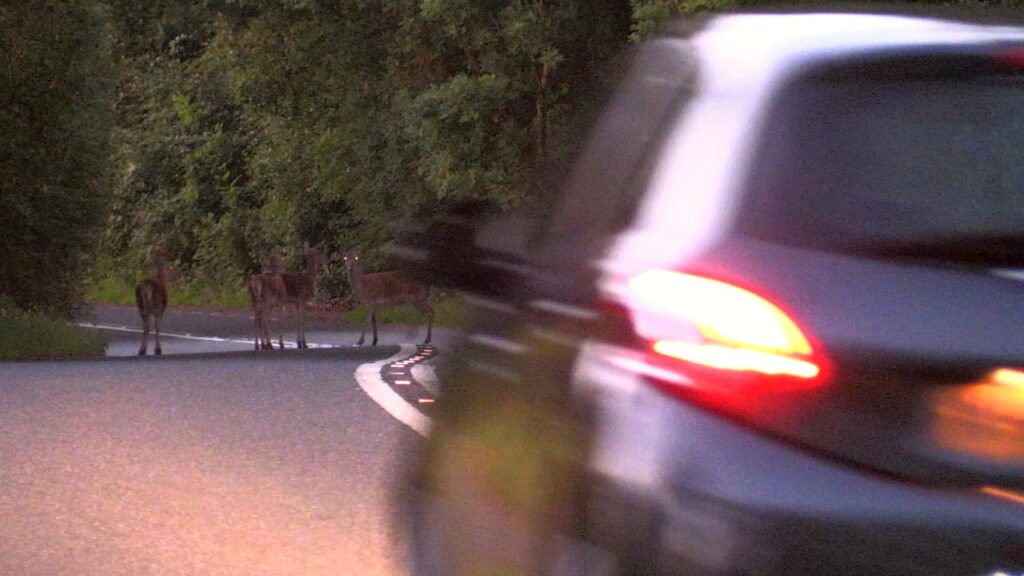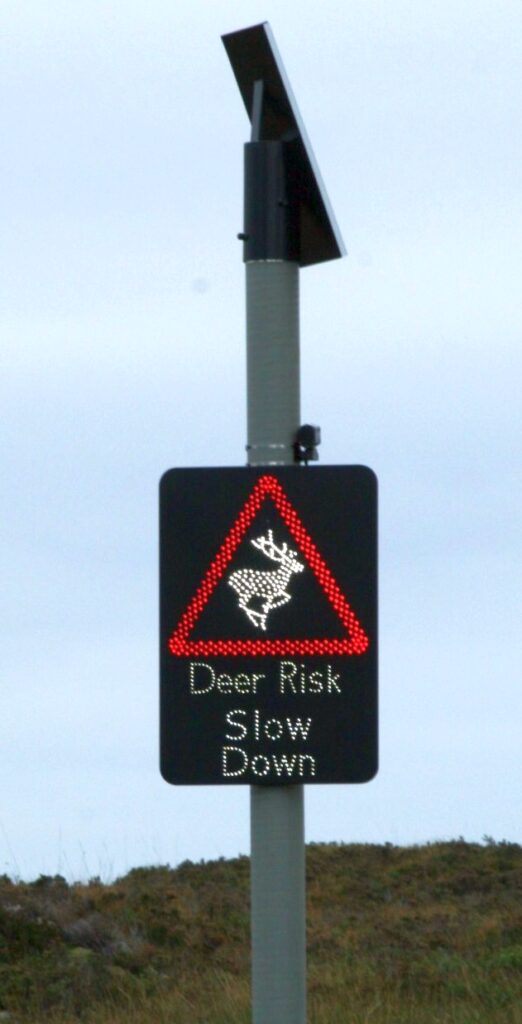Often very casually it seems – not least post lockdown !

During May this year a TV media company asked if they could license some of my now quite old “deer-near-misses and crashes” CCTV footage for an upcoming programme. Although several of those clips have been widely used by past TV programs to help illustrate the very real risk of deer-vehicle collisions on our roads, many were recorded at relatively low resolution (necessitated by field storage of the 24/7 filming set-ups developed for a past deer behaviour research project).
As a ‘post-lockdown’ filming project this June, therefore, I decided to see if I could obtain some higher quality direct-shot video of wild red deer crossing a major road. I chose the A39 Nether Stowey to Williton Road, a busy road not far from home with known high risk of deer collisions, which runs along the edge of the Quantock Hills. This stretch of the A39 is already one of the busiest routes into West Somerset and being located within 4 miles of Hinkley C – one of Europe’s largest nuclear power construction projects – traffic volumes are set to continue to rise year on year for another decade.
The best chance of filming wild deer crossing roads during daylight tends to be around dawn. The downside of filming at dawn in June is that this means getting up at 3.30 am! Nevertheless, I headed out before first light a number of times, knowing that even in the event that I’d fail to film any deer crossing the road, I’d be able to listen to a spectacular early summer dawn chorus. Much to my own surprise it was very worthwhile. The 6-minute compilation of footage at the link below was all filmed during two early morning sessions in mid-June 2020 (with exception of the last few seconds filmed in winter).
One striking aspect (no pun intended) of the footage is how casually these red deer behave at the roadside. Despite the very early time of day there was already some traffic by 4am, including service buses taking workers to the construction site at Hinkley. The deer however, on returning to the hills from grazing on the lower ground at night are seen to amble across or even stand in the middle of the road for prolonged periods. Commonly the deer left only at the last second when traffic approaches closely, or even run out in front of cars that are already within 20 metres of them. Look out for several near-misses in the video. Although deer will generally hear approaching motorised vehicles, deer living in the vicinity of major roads can become habituated to regular background traffic noise and don’t necessarily associate it with danger. It is apparent also that even when deer may be fully aware of the noise from an approaching vehicle, they are extremely poor at being able to judge how quickly that vehicle will be upon them.
The very casual nature with which the deer cross roads in my clips may well have been exacerbated further by the deer having become used to the much lower than usual levels of traffic during ‘Lockdown-1’ in April and May. Unfortunately, the comparatively low levels of traffic during lockdown also led to higher average speeds by drivers in many parts of the country – often blissfully unaware that deer or other animals were just as likely or even more likely to be on the roads.
In a normal year deer-vehicle collisions (DVCs) tend to peak during May when young deer of all species (but especially Roe deer ) tend to disperse from their natal ranges, followed by another peak in late October/early November when our larger deer species (red, sika, fallow) tend to cross roads more frequently on their way to and from their autumn mating grounds. That later peak may also be influenced by the rather sudden co-incidence of dawn and dusk with the peak hours of road traffic when the clocks go back. For more on ‘Why do deer collisions peak in Spring and Autumn’ see that earlier blog.
In this extraordinary year of Covid-19 restrictions however, the imminent further relaxation of lockdown rules from 23 to 28 December, and the sudden increase then in travel by road is predicted to result in a significant increase in collisions with deer and other wild animals during that period; not least, as similar during the first lockdown, animals are likely to have become accustomed to quieter roads. It will pay drivers to take particular heed, especially during the coming 🎄Christmas Period 🎄 to: “Watch out and Slow Down where near maybe near.”
So – what more can be done to reduce the incidents of deer-vehicle collisions in general, and for the particular local example hotspot? There are numerous methods that may help – ranging from roadside fencing, to under- and overpasses, wildlife deterrents / warning devices, to signage and raising driver awareness by other means. Which method, or usually which combination of approaches, are most appropriate will depend on the road class (motorways & dual carriageways / A-road single / more minor roads). [for an overview table of DVC mitigation methods and their effectiveness in differing contexts see this link].

In the case of the example red deer DVC hotspots along the A39, possibly one of the most appropriate and effective measures could be solar powered digital warning signs such as those in the picture below. Digital signage like this, displaying a lit up ‘Stag emblem’ (as per the standard highways code wild animal crossing sign), is intended to alert drivers to the fact that they are entering a ‘high risk of deer crossing’ area. They can be set to activate only above a chosen speed of approaching vehicles. Similar signs have been employed along several main A-roads in the Scottish Highlands (targeted at known DVC hotspots) with promising results in terms of reductions in average driver speed.
Previously, in 2006 Somerset CC supported a trial by a different method: acoustic roadside wildlife deterrents that emit audible whistling signals when activated by vehicle headlights. Following their installation along two half-mile stretches incidence of DVCs along the road did reduce for a number of years. However, the trial was not fully conclusive, as a number of other factors also changes around the same time, including a reduction in deer numbers in that area as well as new speed limits, making it not possible be sure which contributed most to DVC reductions observed. The solar-charged batteries were also only ever expected to last for 5 years, and although many lasted much longer, most are now no longer active. Replacement of these possibly using newer more advanced ‘active’ wildlife warning device models using flashing light- and variable sound signals (such as Deer-Deter – see video link to Cannock Chase trial ) might also be worth considering, but would likely best done in combination with enhanced digital signage to alert drivers and help reinforce the existing 50mph speed limit. In the present economic climate, however, it seems likely more funding for such measures will be difficult to find.
In the meantime, therefore, please remember, especially on rural roads to:
- Take note of deer warning signs. Speed restrictions on roads are the legal limit NOT a target.
- When you see one deer cross – always watch out for another !
- After dark, do use full beam when there is no oncoming traffic. BUT, when a deer or other animal is noted on the road, dim your headlights as animals may be startled by the beam and ‘freeze’ rather than leaving the road.
- Don’t over-swerve to avoid hitting a deer, swerving into oncoming traffic or off the road surface could be even worse.
- Be aware of vehicles behind you before braking sharply and use your hazard lights.
- For further advice regarding what to do if you have hit a deer or see an injured animal at roadside see also Deer Aware : https://www.deeraware.com/safety-advice/
Look out also shortly at the British Deer Society web-site and their social media for their ‘Deer on Roads’ Webinar recorded, and now published at this Youtube link
Thanks also to the numerous local residents who have commented on my social media post on 3/4 December regarding deer collisions and near misses along the A39 and A358. Over 100 comments in less than a day, showed vast majority of local respondent (>74%) had collisions or near misses with deer in along the A39 between West Quantoxhead and Nether Stowey, but a fair few mentioning also A358 Taunton to Williton, and various other know risky areas along A396 Dunster-Timberscombe, and near Dulverton, and A39 Porlock Hill.




test comments